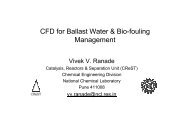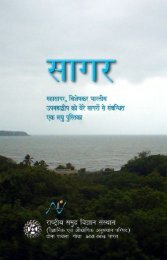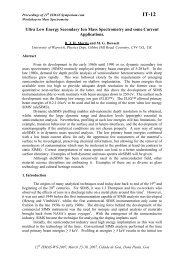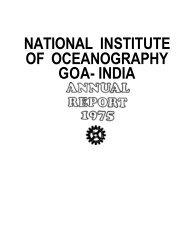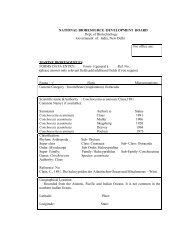1980 - National Institute of Oceanography
1980 - National Institute of Oceanography
1980 - National Institute of Oceanography
You also want an ePaper? Increase the reach of your titles
YUMPU automatically turns print PDFs into web optimized ePapers that Google loves.
particular substance has been detected in Caulerpa racemosa (hypotensive), Padina<br />
tetrastomatica (spasmogenic), Corallina (spasmogenic) and Chondria armata (spasmogenic).<br />
It is to be confirmed whether the activity reported is due to the presence<br />
<strong>of</strong> histamine. The extracts <strong>of</strong> Sargassum tenerrimum, Galaxaura elongata, Galaxaura<br />
rugosa, Ulva reticulata, Chondrococcus sp. and Codium elongatum were found to be<br />
devoid <strong>of</strong> histamine.<br />
4. Halogens in algae<br />
Iodine and bromine contents were measured in 16 species <strong>of</strong> red, brown and<br />
green algae. In all the species examined the concentration <strong>of</strong> iodine was found to be<br />
lower than that <strong>of</strong> the bromine. Phaeophyta and Rhodophyta were found to be<br />
relatively richer in both these elements. The iodine concentration varied from 0.003<br />
to 0.119% and bromine from 0.008 to 0.128%.<br />
3.2.3 Protection <strong>of</strong> marine environment and monitoring <strong>of</strong> pollutants along the Indian coast<br />
The studies under this project were carried out partly from headquarters and<br />
partly from Regional Centres, Cochin and Bombay.<br />
1. Monitoring <strong>of</strong> petroleum hydrocarbons in the marine environment<br />
Two cruises were carried out along the oil tanker routes across the southern<br />
Bay <strong>of</strong> Bengal from south <strong>of</strong> Sri Lanka to the head <strong>of</strong> the Malacca Strait. The area<br />
traversed was between 5°30' to 6°30'N latitude and 78°00' to 98°30'E longitude.<br />
A part <strong>of</strong> the Andaman Sea was also surveyed. The components observed were: oil<br />
slicks, floating pollutants, particulate petroleum residues (tar balls) and dissolved/<br />
dispersed hydrocarbons.<br />
Depthwise mean concentration in μg/kg <strong>of</strong> dissolved/dispersed petroleum hydrocarbons<br />
along the oil tanker route in the Arabian Sea and Bay <strong>of</strong>.Bengal are as<br />
follows:<br />
Arabian Sea (μg/kg) Bay <strong>of</strong> Bengal (μg/kg)<br />
Depth Mean Range Mean Range<br />
0 m 35.3 0-395 29.1 4-229<br />
10 m 30.6 3-217 25.1 2-147<br />
20 m 29.4 2-112 17.6 1-75<br />
Mean 32.5 Mean 24.1<br />
Computation on the total volume <strong>of</strong> petroleum hydrocarbons in the upper<br />
20 m <strong>of</strong> the Arabian Sea and the southern Bay <strong>of</strong> Bengal gave figures <strong>of</strong> 4 x 10 6<br />
and 0.4 x 10 6<br />
tonnes respectively.<br />
2. Laboratory studies on biodegradation<br />
Investigations have been initiated to isolate tar-degrading organisms by sequential<br />
degradation method. Laboratory studies gave encouraging results but field<br />
trials on the tar deposition on beaches presented some difficulties due to wind and<br />
surf activities. Modifications are being tried to overcome these problems.<br />
33



